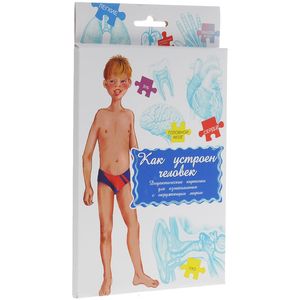Little Genius Press. Educational flashcards. How does a human work?
Please sign in so that we can notify you about a reply
Dear adults!
Card classes will help you to introduce a child with the outside world, develop speech skills, teach to compare, classify, summarize.
From 6 months:
Show cards quickly, clearly called the drawn item. Set to show several days, then replace the new one. After some time, repeat the show.
From 3 years:
Play with the child:
Obtain with the child, what items he sees in the pictures, for which they are intended.
Occasionally describe any toy drawn in pictures without calling it. Invite the child to guess what is we talking about, and choose the appropriate card. Then change with the child places: it describes - you are guessing.
Perform a queue with a child to question What? "," for what? " Regarding each item, try to give more answers.
Observe what toys with the child, he likes the most. Compare toys in pictures with real toys: baby, find similarities and differences.
o If the child is already learning to read, cut the names, mix and propose to choose the names to the pictures. Other than several sets, you can play logical games:
- classification (sort cards on the subject, select a generalizing name),
- The fourth extra (out of four cards: three on one topic and one to another, the child must choose too much and explain its choice).
Can be used in individual and group work by speech therapists, psychologists, educators of preschool institutions, primary school teachers
Card classes will help you to introduce a child with the outside world, develop speech skills, teach to compare, classify, summarize.
From 6 months:
Show cards quickly, clearly called the drawn item. Set to show several days, then replace the new one. After some time, repeat the show.
From 3 years:
Play with the child:
Obtain with the child, what items he sees in the pictures, for which they are intended.
Occasionally describe any toy drawn in pictures without calling it. Invite the child to guess what is we talking about, and choose the appropriate card. Then change with the child places: it describes - you are guessing.
Perform a queue with a child to question What? "," for what? " Regarding each item, try to give more answers.
Observe what toys with the child, he likes the most. Compare toys in pictures with real toys: baby, find similarities and differences.
o If the child is already learning to read, cut the names, mix and propose to choose the names to the pictures. Other than several sets, you can play logical games:
- classification (sort cards on the subject, select a generalizing name),
- The fourth extra (out of four cards: three on one topic and one to another, the child must choose too much and explain its choice).
Can be used in individual and group work by speech therapists, psychologists, educators of preschool institutions, primary school teachers
Cover:
Cover:Other
Category:
- Category:Education & Teaching
- Category:Science & Math
Paper:
Paper:Molded
ISBN:
ISBN:4607054090801
No reviews found
